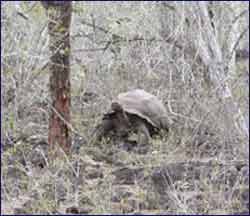New taxon of Galápagos tortoise identified

Unnamed taxon of Galapagos Tortoise
Almost 150 years after Charles Darwin proposed a mechanism for biological evolution, previously unrecognized diversity has been discovered among the giant tortoises of the Galápagos, Geochelone nigra, whose distinctiveness was an inspiration in formulating the theory of natural selection.
The new taxon (species or sub-species) of Galápagos tortoise was characterized by a team of scientists led by Michael Russello, Adalgisa Caccone and Jeffrey Powell in the Department of Ecology and Evolutionary Biology at Yale. Conservation of its habitat is an immediate concern because the human population on the island of Santa Cruz is growing rapidly. The team emphasized the importance of accurate taxa identification for effective conservation policy and preservation of genetic diversity in a recent report in Biology Letters published by the Royal Society of London.
The current tortoise populations on the island of Santa Cruz, long believed to comprise a single taxon, are in fact, three genetically distinct lineages that are yet to be formally named.
While visible characteristics, like the shapes of their shells, were the basis for previous classification of the tortoises, this research team used a variety of molecular genetic and analytical tools including mitochondrial DNA analysis from extinct taxa. The comprehensive study of these tortoises throughout Galápagos made their discovery possible.
Currently 11 of the recognized 15 taxa of tortoise are living and continue to be endangered throughout the Galápagos. Only 2,000 – 4,000 individual tortoises remain on Santa Cruz, and there may be as few as 100 individuals of the new taxon.
“It is ironic that while Santa Cruz has the largest population of tortoises, it also has the largest human population –projected to double in the next eight years — which is their greatest source of endangerment,” said Russello. “Since accurate taxonomy is crucial for effective conservation policy, these results have fundamental importance for preserving the genetic and taxonomic diversity of these historically-significant reptiles.”
Collaborators included Scott Glaberman at Yale, James P. Gibbs at the State University of New York (Syracuse), and Cruz Marquez at the Charles Darwin Research station, Santa Cruz, Ecuador. The study was funded through the ECOSAVE project of the Yale Institute for Biospheric Studies and a National Geographic grant.
Media Contact
More Information:
http://www.yale.eduAll latest news from the category: Ecology, The Environment and Conservation
This complex theme deals primarily with interactions between organisms and the environmental factors that impact them, but to a greater extent between individual inanimate environmental factors.
innovations-report offers informative reports and articles on topics such as climate protection, landscape conservation, ecological systems, wildlife and nature parks and ecosystem efficiency and balance.
Newest articles

“Nanostitches” enable lighter and tougher composite materials
In research that may lead to next-generation airplanes and spacecraft, MIT engineers used carbon nanotubes to prevent cracking in multilayered composites. To save on fuel and reduce aircraft emissions, engineers…

Trash to treasure
Researchers turn metal waste into catalyst for hydrogen. Scientists have found a way to transform metal waste into a highly efficient catalyst to make hydrogen from water, a discovery that…

Real-time detection of infectious disease viruses
… by searching for molecular fingerprinting. A research team consisting of Professor Kyoung-Duck Park and Taeyoung Moon and Huitae Joo, PhD candidates, from the Department of Physics at Pohang University…





















